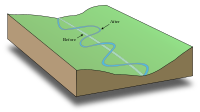
Photo from wikipedia
A meander system is a union of two arc systems that represent non-crossing pairings of the set $$[2n] = \{1, \ldots , 2n\}$$ in the upper and lower half-plane. In… Click to show full abstract
A meander system is a union of two arc systems that represent non-crossing pairings of the set $$[2n] = \{1, \ldots , 2n\}$$ in the upper and lower half-plane. In this paper, we consider random meander systems. We show that for a class of random meander systems,—for simply-generated meander systems,—the number of cycles in a system of size n grows linearly with n and that the length of the largest cycle in a uniformly random meander system grows at least as $$c \log n$$ with $$c > 0$$ . We also present numerical evidence suggesting that in a simply-generated meander system of size n, (i) the number of cycles of length $$k \ll n$$ is $$\sim n k^{-\beta }$$ , where $$\beta \approx 2$$ , and (ii) the length of the largest cycle is $$\sim n^\alpha $$ , where $$\alpha $$ is close to 4/5. We compare these results with the growth rates in other families of meander systems, which we call rainbow meanders and comb-like meanders, and which show significantly different behavior.
Journal Title: Journal of Statistical Physics
Year Published: 2020
Link to full text (if available)
Share on Social Media: Sign Up to like & get
recommendations!